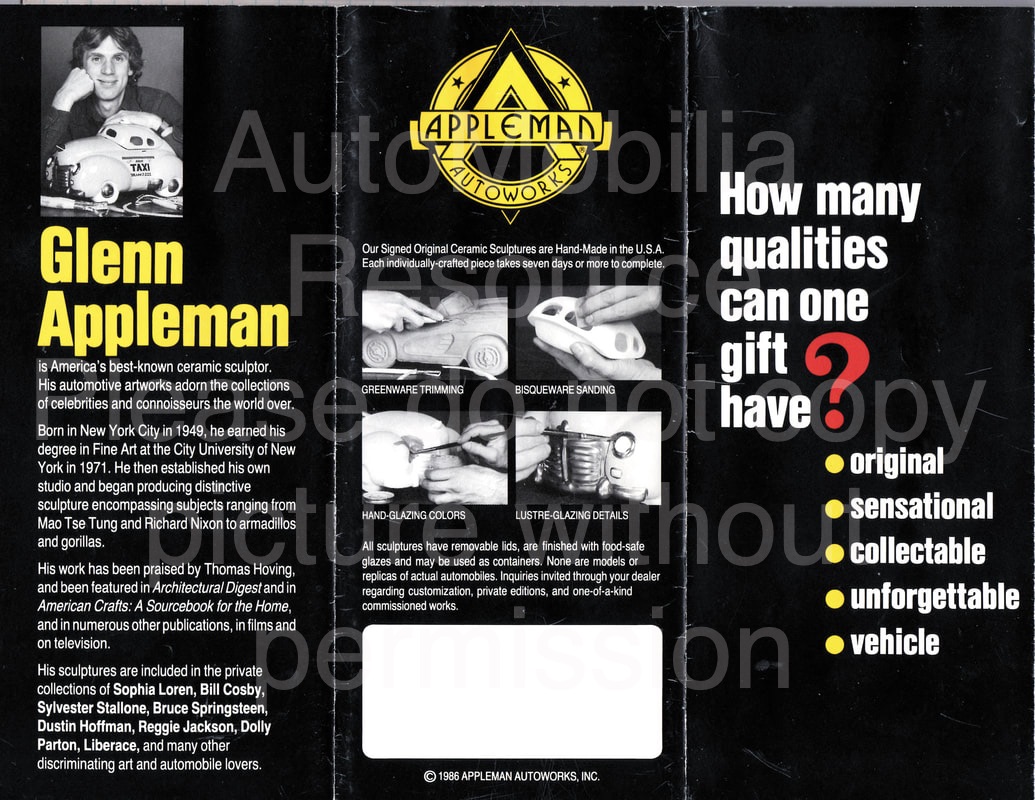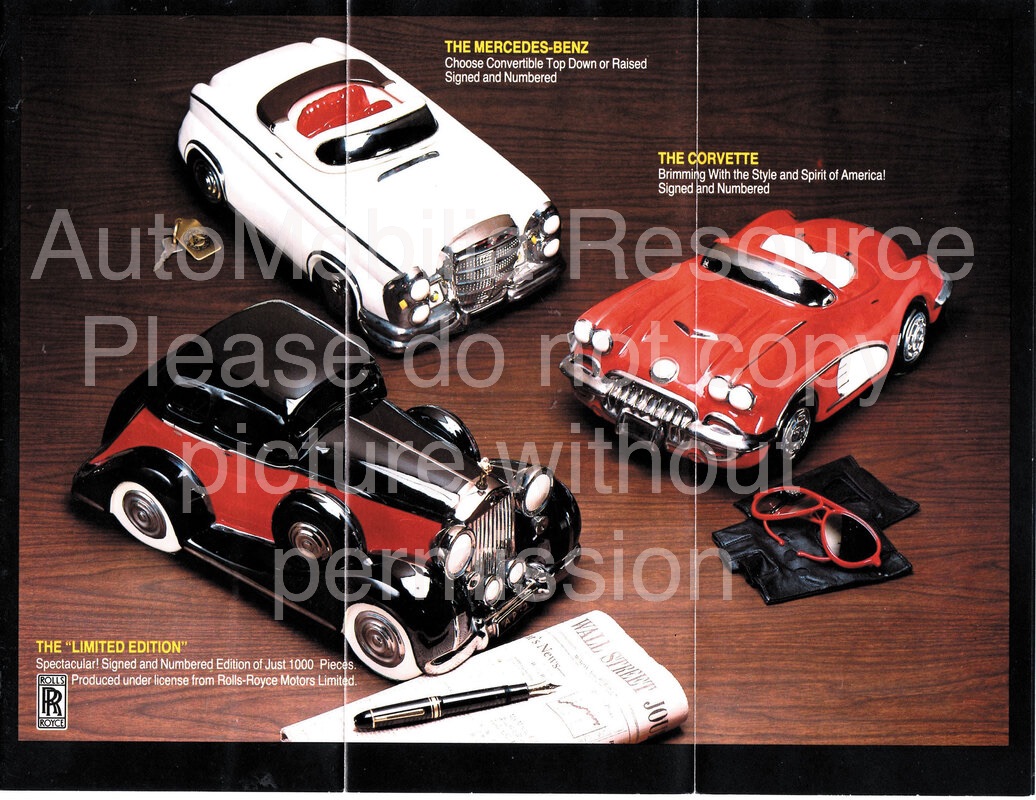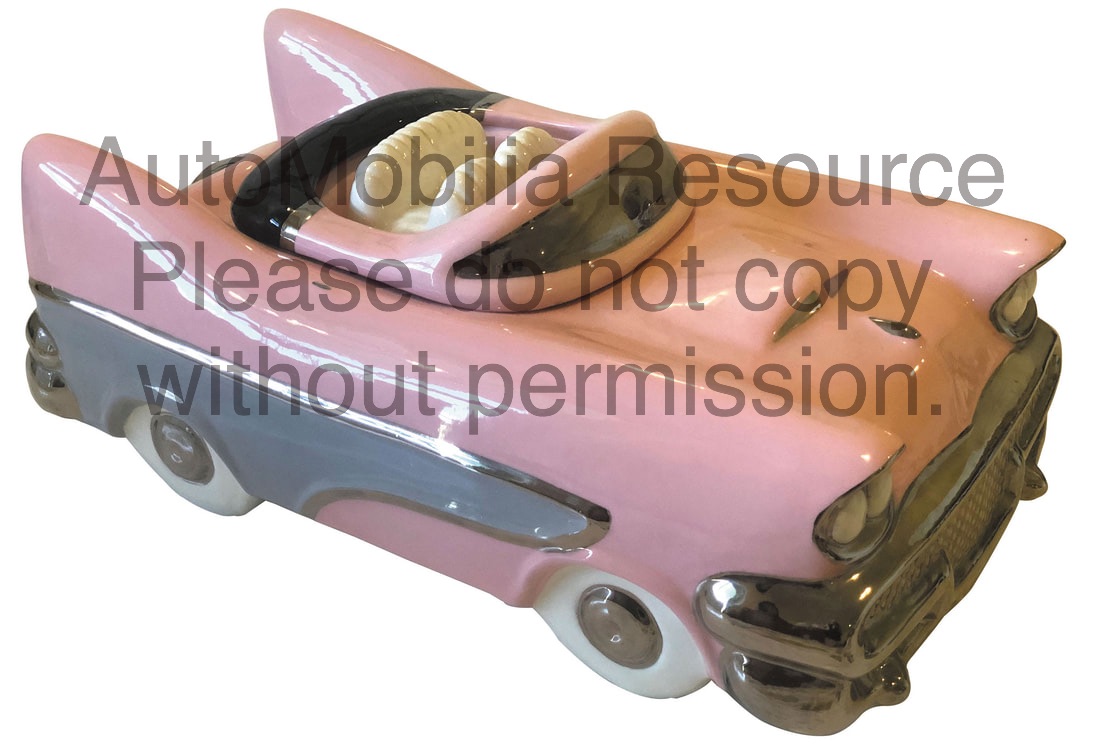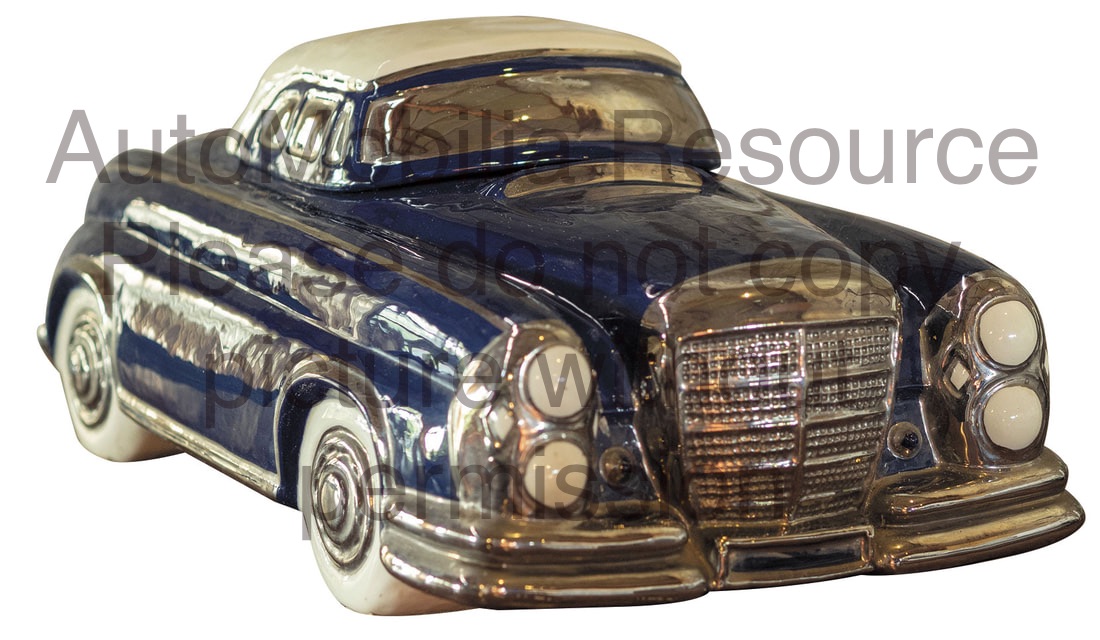|
Jan/Feb 2021 edition Issue #14, AutoMobilia Resource Magazine Ken Gross Appleman CerAmic Cookie Jars: Worth a Lot of Dough... In Automobilia #13, we learned about Glenn Appleman’s whimsical and now very valuable collectable cookie jars. For this second installment, Glenn tells us how the cookie jars were made, and tells some funny stories about the famous people who were his customers — and he hints about a cookie jar to come…! “They were $70-75 apiece when we started, then they went up in price,” he said. “We moved out to New Jersey and we started paying some real expenses, so prices inevitably went up. That was one of the things that eventually made us go out of business. Expenses were spiraling. We got a letter saying that my workman’s comp insurance had to be for a hazardous business, and they tripled the premium.” The process was time-consuming and labor-intensive. “We used the slip cast method,” Glenn explains. “You make an original out of a solid block of clay, then you fire it, so you have a heavy solid piece – you do the same for the lid. Next you make a mold for the different pieces, like the teeth in the grille, etc. Most car molds were six pieces, bottom, top, sides, front. Each mold weighed about 80 pounds. Then you make a mold of the mold, called a block and case. Finally, you make copies of that so you can mass produce them.” “Slip is clay, like Turkish taffy – you fill up the mold, with a couple of gallons. The plaster is a desiccant – it takes the water away and dries out the casting. The clay sits in the mold for a half-hour, then you dump the excess out. Inside the mold, there’s a coating. You pop open the molds and lift the piece out. Then they’d trim it and remove the casting flash line. There’s a bisque firing, then it’s on to the glaze kiln for color, and the decals, and finally, we added the chrome luster glaze, made of platinum and gold. Then I signed it, put felts under the four wheels and shipped it. A car was about a week in the pipeline. It took 14 people, many of them were part time.”  Above and Below: The Jaguar XK140 Cookie Jar was especially made for Stephen Ring, a Long Island-based Jaguar enthusiast. Ring ordered five of these. Glenn says he did “about 10 or 15 more,” (a few in white) but they were never widely sold, making them one of the rarest Appleman cookie jars. Note the signed underside. Glenn planned to tool up for these but then decided against it. If you can find one today, you’ve hit the Appleman jackpot! “But the rent and electricity and the price of labor were all going up. It was hard to find people who would work for what we could afford to pay them. It was a perfect storm kind of thing. It was definitely time to take a rest. So, we stopped producing. We’d had a factory, a loft in Union City, N.J. with lots of molds and kilns. Most of it was trashed at that point. I’d worked it so hard that there wasn’t much to save. Some molds I put in my basement and they’re still in my basement.” There are a few especially rare examples. Jaguar roadster: “Stephen Ring is a Jaguar enthusiast on Long Island. He ordered five Jaguar’s, and we did a cross between an XK-120 and an XK-140. I might have made 15 Jaguars in total.”
Truman and Dewey: “I created a special piece with President Truman holding that famous ‘Dewey Beats Truman’ newspaper. It was done for a PBS Channel 13 auction. People made donations to win one. It was a big kick. Hey, I’m on TV! Maybe six to ten of those were made.” Now it can be told: The Appleman promotional flyer highlighted famous people who owned Appleman cookie jars. “We never met any of the celebrities,” Appleman confesses. “A friend of mine saw Reggie Jackson being interviewed on 20/20 [TV News Magazine show], and in the background, there was an Appleman taxicab. My partner Harry wrote the catalog, saying that Reggie was an owner. His lawyer called and threatened to sue us. I said, ‘what if we send Reggie a bunch of cars, so we could use his name?’ – We sent the cars and one arrived broken. I received an angry letter, signed by Reggie. He chastised us, but he owns several of my cars. And I have a Reggie Jackson collectable letter!” “We believe Sophia Loren bought a car, but we never met her.” And then there was Liberace. “Sam Levine, Liberace’s manager, contacted us because his Rolls-Royce was broken, so I said, ‘I will make Liberace a new Rolls-Royce.’ We didn’t know how to spell Liberace – there was no internet then to look it up. But we found out how to spell it, and we put Liberace’s name on the license plate. Epilogue: “It’s been over 30 years since I went out of business,” Glenn says. “A lot has happened. I took computer programming at NYU, and I went to work as a computer programmer for the American Management Association. And now, 32 years later, I am about to retire.” “My girlfriend and I talked about my making another car. I don’t draw very well. We decided I would start sculpting the car next summer.” You heard it here first, cookie jar collectors! Glenn doesn’t want to speculate on the price, it’s too early for that, but he sounds serious. I’d start saving up. Ken Gross To read more great columns like this one
|
| Most of the Appleman cookie jars that I’ve ever seen, including four of the five examples I own, are signed and dated in Sharpie-type ink with the signature, “Appleman,” on the unpainted bottom. Examples of these artsy jars were owned by notables like Andy Warhol, Sofia Loren, Sylvester Stallone, Dustin Hoffman, Reggie Jackson, Dolly Parton and Bill Cosby. They were spotted in photographs when celebrity photographers performed shoots of their famous subjects’ homes for magazines. |
The most popular Appleman cookie jar was the “Humperbump,” also known as “Sid’s Radio Taxi,” which is bright yellow, and was offered with several different taxi company labels. I own an Appleman Packard convertible in brown, and I have seen the same jar in green and white. It was also offered as a coupe in police car colors. The black Appleman 1952 Buick coupe was also available in white, red, and robin’s-egg blue. Other Appleman jars came in the exaggerated shapes of a red or a white Corvette, a Rolls-Royce (in several colors), a Mercedes-Benz convertible (in red, blue or white), and – one of the rarest types – a red Buick convertible with ten small ceramic cats playing on its hood and interior. I own a pink and gray DeSoto convertible, as well.
Prices are all over the lot: as I write this, there’s a black and yellow Rolls-Royce on eBay for $1,800 and a black Mercedes-Benz convertible that’s “Buy it Now” for $1,000. Packards and Buicks run from $350 to $500 or more. Cited in a list of top-selling cookie jars, “10 Cats and a Buick” sold on eBay for $1,611 in 2011.
For years, I wanted to know more about these cute ceramic novelties, so after I read the AutoMobilia Resource article on Sadler OKT42 teapots in issue #12, I told Editor Marshall Buck I’d like to research the Appleman items for an article. I only knew what you’ve just read. But I wanted to know much more.
Publisher Sharon Spurlin suggested we run an ad in their classifieds, along with a photo of “Sid’s Radio Taxi,” to see if a reader could help us with more information. We struck gold on the first day when I received a call from Stephen Ring, who’d ordered a limited-production Jaguar cookie jar from Glenn Appleman (more about this in part II, issue 14 of AutoMobilia Resource).
Stephen said he thought Glenn lived in Brooklyn, and he believed he hadn’t been making the cookie jars for decades. He didn’t have Glenn’s phone number, but through the magic of the Internet, I was soon speaking with the elusive Mr. Appleman.
Friendly, enthusiastic and blessed with a great memory, Glenn Appleman was only too happy to tell me all about his short-lived career as a cookie jar magnate.
For years, I wanted to know more about these cute ceramic novelties, so after I read the AutoMobilia Resource article on Sadler OKT42 teapots in issue #12, I told Editor Marshall Buck I’d like to research the Appleman items for an article. I only knew what you’ve just read. But I wanted to know much more.
Publisher Sharon Spurlin suggested we run an ad in their classifieds, along with a photo of “Sid’s Radio Taxi,” to see if a reader could help us with more information. We struck gold on the first day when I received a call from Stephen Ring, who’d ordered a limited-production Jaguar cookie jar from Glenn Appleman (more about this in part II, issue 14 of AutoMobilia Resource).
Stephen said he thought Glenn lived in Brooklyn, and he believed he hadn’t been making the cookie jars for decades. He didn’t have Glenn’s phone number, but through the magic of the Internet, I was soon speaking with the elusive Mr. Appleman.
Friendly, enthusiastic and blessed with a great memory, Glenn Appleman was only too happy to tell me all about his short-lived career as a cookie jar magnate.

Here are four of the most popular – the red Buick convertible (2 versions). The Buick with ten cats was made because the red glaze reportedly was difficult to apply without producing black spots. Appleman’s solution was to craft tiny cats to cover the spots, making for an even more impressive item. “10 Cats on a Buick” is one of the most expensive cookie jars today. “Sid’s Taxi” was the most popular cookie jar. “Phantazoon,” the DeSoto convertible, was also offered in black.
“I was born in the Bronx in 1949,” he said. “I studied fine art at City University of New York. I always wanted to be an electrical engineer like my uncle Harold. But I was never good at calculus, so I decided I wouldn’t be an engineer. I was in the ceramic room at City College and the student aide was a friend; so, I never left. Ceramics was a lot more fun than calculus.”
“I didn’t initially make these pieces as cookie jars.” Appleman explains. “I called them objets d’art. But people thought of them as cookie jars. Who was I to argue?”
“Besides, cookie jars became a hot collectable after Andy Warhol died and his collection of 175 jars was auctioned off by Sotheby’s in 1987. They brought over $250,000. People thought if Andy Warhol was collecting cookie jars, they must be art.”
“I didn’t initially make these pieces as cookie jars.” Appleman explains. “I called them objets d’art. But people thought of them as cookie jars. Who was I to argue?”
“Besides, cookie jars became a hot collectable after Andy Warhol died and his collection of 175 jars was auctioned off by Sotheby’s in 1987. They brought over $250,000. People thought if Andy Warhol was collecting cookie jars, they must be art.”
| “That first car, the Sid’s Taxi, was known and marketed as the “Humperbump.” The next car out was the Packard, in 1979. Then I thought it would be cool if I made a convertible out of it. So, the Packard had two different lids and it also became a police car. In 1980, I made the first Buick – a 1952 model with a big grille that looked like a Viking battering ram. In 1981, things were slow. I didn’t have enough money to make a new car, so I came out with a Buick convertible by designing a different top. And I offered them in different colors.” |
“In late 1981, I did the DeSoto convertible, which was actually called the Phantazoom. I thought it would be a great idea to use the crazy two-tone colors of the 1950s, so I could make pink cars and purple cars. I moved out to New Jersey in 1982, and the first car there was the limited-edition Rolls-Royce. I recently saw one on eBay with an intact hood ornament, which amazes me. They weren’t really designed for the long haul.”
“And that was it. Two years later, we went out of business.”
| “I was fortunate enough to pick up the beginning of the wave of the crafts movement in America. There were craft galleries and books. Art collectors were starting to acknowledge American crafters as artists. And there were many craft shows. The Rhinebeck show was the most famous, and there was one in Baltimore. The American Craft Council (ACC) still exists. They managed the shows. Dealers would order, and you went home and made stuff. We had a few department store orders, from I. Magnin & Company, and Marshall Field.” |
“But toward the end of the 1980s, the craft thing was starting to die. Galleries were disappearing. Main Street had had its flirtation with it. And then it ended, as trends do end.” Looking back, Glenn believes he made about 20,000 cars, “give or take a few thousand.” And he made one last small run of taxis in the early 1990s.
“I looked at the crystal ball and realized, we’re not growing, we’re shrinking, and I said, ‘I’ve been doing it for ten years, and I’m tired. I think I’ll do something else.’ I went back to college and I have been a computer programmer ever since.”
“I looked at the crystal ball and realized, we’re not growing, we’re shrinking, and I said, ‘I’ve been doing it for ten years, and I’m tired. I think I’ll do something else.’ I went back to college and I have been a computer programmer ever since.”
| The business initially seemed successful, so I asked Glenn if there were other reasons that contributed to its demise. We’ll learn about Glenn’s famous clientele and preview a future Appleman design next issue, in AutoMobilia Resource #14. Ken Gross |
To read more great columns like this one
from Appleman Cookie Jar expert Ken Gross...
Subscribe to AutoMobilia Resource
from Appleman Cookie Jar expert Ken Gross...
Subscribe to AutoMobilia Resource
Ken Gross
Ken Gross has written over 15 books and numerous articles for automotive magazines. He collects Sadler OKT42 teapots, Glenn Appleman cookie jars and Ford flathead speed equipment.
[email protected]





















 RSS Feed
RSS Feed